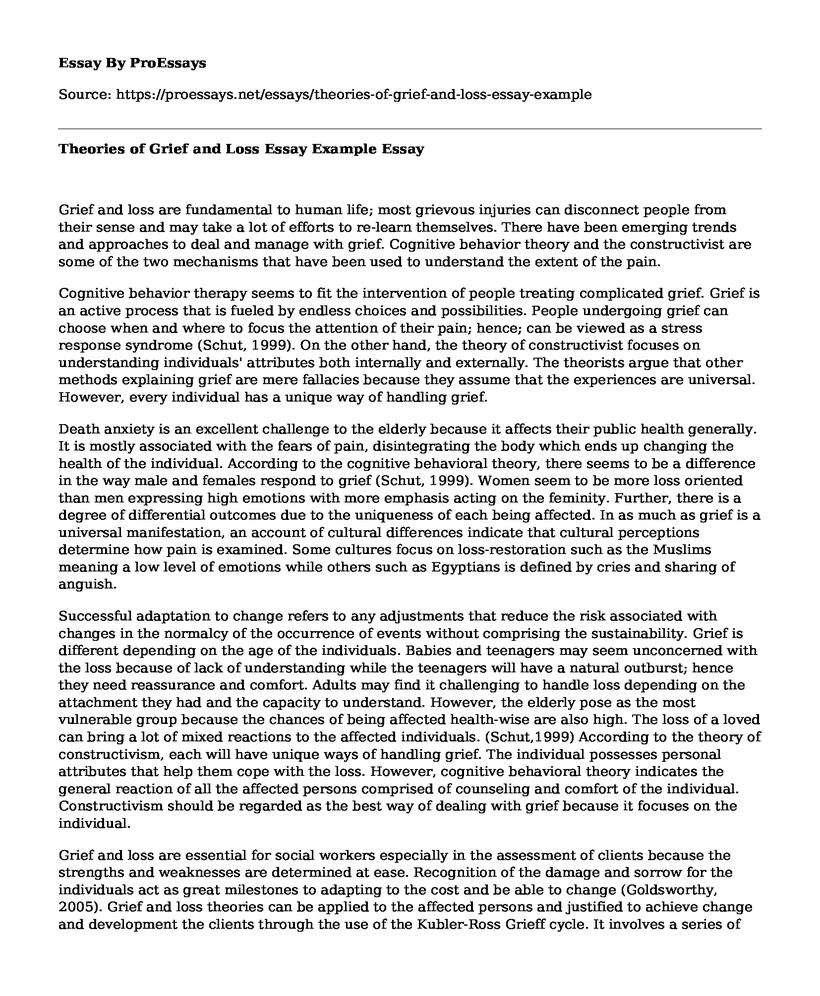Grief and loss are fundamental to human life; most grievous injuries can disconnect people from their sense and may take a lot of efforts to re-learn themselves. There have been emerging trends and approaches to deal and manage with grief. Cognitive behavior theory and the constructivist are some of the two mechanisms that have been used to understand the extent of the pain.
Cognitive behavior therapy seems to fit the intervention of people treating complicated grief. Grief is an active process that is fueled by endless choices and possibilities. People undergoing grief can choose when and where to focus the attention of their pain; hence; can be viewed as a stress response syndrome (Schut, 1999). On the other hand, the theory of constructivist focuses on understanding individuals' attributes both internally and externally. The theorists argue that other methods explaining grief are mere fallacies because they assume that the experiences are universal. However, every individual has a unique way of handling grief.
Death anxiety is an excellent challenge to the elderly because it affects their public health generally. It is mostly associated with the fears of pain, disintegrating the body which ends up changing the health of the individual. According to the cognitive behavioral theory, there seems to be a difference in the way male and females respond to grief (Schut, 1999). Women seem to be more loss oriented than men expressing high emotions with more emphasis acting on the feminity. Further, there is a degree of differential outcomes due to the uniqueness of each being affected. In as much as grief is a universal manifestation, an account of cultural differences indicate that cultural perceptions determine how pain is examined. Some cultures focus on loss-restoration such as the Muslims meaning a low level of emotions while others such as Egyptians is defined by cries and sharing of anguish.
Successful adaptation to change refers to any adjustments that reduce the risk associated with changes in the normalcy of the occurrence of events without comprising the sustainability. Grief is different depending on the age of the individuals. Babies and teenagers may seem unconcerned with the loss because of lack of understanding while the teenagers will have a natural outburst; hence they need reassurance and comfort. Adults may find it challenging to handle loss depending on the attachment they had and the capacity to understand. However, the elderly pose as the most vulnerable group because the chances of being affected health-wise are also high. The loss of a loved can bring a lot of mixed reactions to the affected individuals. (Schut,1999) According to the theory of constructivism, each will have unique ways of handling grief. The individual possesses personal attributes that help them cope with the loss. However, cognitive behavioral theory indicates the general reaction of all the affected persons comprised of counseling and comfort of the individual. Constructivism should be regarded as the best way of dealing with grief because it focuses on the individual.
Grief and loss are essential for social workers especially in the assessment of clients because the strengths and weaknesses are determined at ease. Recognition of the damage and sorrow for the individuals act as great milestones to adapting to the cost and be able to change (Goldsworthy, 2005). Grief and loss theories can be applied to the affected persons and justified to achieve change and development the clients through the use of the Kubler-Ross Grieff cycle. It involves a series of stages that is applied to the individuals as a process of helping them slowly be able to handle the loss. It entails helping the clients deal with denial, anger, then helping them finding the meaning and reaching out to others, dealing with depression and finally accepting the loss ( Stringer, 2010). The theories have been assisting in explaining how each stage is handled effectively.
Conclusion
Personal grief and loss can cause negative impacts mainly in the line of practice such as job loss resulting in unemployment stress. It consumes a lot of time to grieve over the loss of a job. Again, looking at the positive side, loss and grief can strengthen you to be able to cope with painful emotions and can be a stepping stone to greatness.
References
Goldsworthy, K. K. (2005). Grief and loss theory in social work practice: All changes involve loss, just as all losses require change. Australian Social Work, 58(2), 167-178.
Neimeyer, R. A., Burke, L. A., Mackay, M. M., & van Dyke Stringer, J. G. (2010). Grief therapy and the reconstruction of meaning: From principles to practice. Journal of Contemporary Psychotherapy, 40(2), 73-83.
Schut, M. S. H. (1999). The dual process model of coping with bereavement: Rationale and description. Death studies, 23(3), 197-224.
Cite this page
Theories of Grief and Loss Essay Example. (2022, Dec 14). Retrieved from https://proessays.net/essays/theories-of-grief-and-loss-essay-example
If you are the original author of this essay and no longer wish to have it published on the ProEssays website, please click below to request its removal:
- Stumbling on Happines
- Annotated Bibliography: Depression and College
- Influence of Technology in Work-Life Balance Essay
- Diverse Personalities Essay
- Trauma Among Victims of Terrorism: Psychological Paper Example
- The Effects of Divorce on Children Paper Example
- Essay Example on Big Little Lies: Therapy & Mental Health in an Upscale California Town







